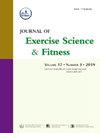Effectiveness of hard court slide braking technique and influencing factors in elite college tennis players
IF 2.4
2区 医学
Q2 SPORT SCIENCES
引用次数: 0
Abstract
Objective
The study aimed to evaluate the effectiveness of hard court slide braking technique of elite college tennis players and to analyze the factors that influence the use of hard court slide braking technique.
Methods
A total of 100 elite tennis players (58 males and 42 females) participated in tests involving hard court hit-to-return and Forcedecks Dual Force Plates System-based physical function. Independent samples t-tests, paired samples t-tests and binary logistic regression were employed in data analysis.
Results
The use of slide braking technique on hard courts, compared to traditional methods, led to a 10 % reduction in time for short-distance shots and a 7 % reduction for long-distance shots (p < 0.001). Athletes skilled in the hard court slide braking technique completed the movement faster when they employed traditional braking technique than those who are unskilled in the hard court slide braking technique (p < 0.001). Key factors that significantly influenced the use of slide braking technique included years of training, left hip abduction, 10-m sprint speed, braking leg reactive strength index (RSI), ground reaction force on the braking leg and recovery balance time of the braking leg (p < 0.05).
Conclusions
The findings offer new perspectives into tennis-specific physical training, assisting more tennis players in enhancing their athletic skills effectively.
高校优秀网球运动员硬地滑轨制动技术的有效性及其影响因素
目的评价高校优秀网球运动员硬地滑块制动技术的使用效果,分析影响硬地滑块制动技术使用的因素。方法对100名优秀网球运动员(男58名,女42名)进行硬地击球回球和基于forcedeck双力板系统的身体机能测试。数据分析采用独立样本t检验、配对样本t检验和二元logistic回归。结果在硬地球场使用滑块制动技术,与传统方法相比,导致近距离击球时间减少10%,远距离击球时间减少7% (p < 0.001)。熟练硬地滑行制动技术的运动员在使用传统制动技术时完成动作的速度比不熟练硬地滑行制动技术的运动员快(p < 0.001)。影响滑梯制动技术使用的关键因素包括训练年限、左髋关节外展、10米冲刺速度、制动腿反应强度指数(RSI)、制动腿地面反作用力和制动腿恢复平衡时间(p < 0.05)。结论本研究为网球专项体能训练提供了新的视角,有助于更多网球运动员有效提高运动技能。
本文章由计算机程序翻译,如有差异,请以英文原文为准。
求助全文
约1分钟内获得全文
求助全文
来源期刊
CiteScore
5.10
自引率
3.60%
发文量
54
审稿时长
31 days
期刊介绍:
The Journal of Exercise Science and Fitness is the official peer-reviewed journal of The Society of Chinese Scholars on Exercise Physiology and Fitness (SCSEPF), the Physical Fitness Association of Hong Kong, China (HKPFA), and the Hong Kong Association of Sports Medicine and Sports Science (HKASMSS). It is published twice a year, in June and December, by Elsevier.
The Journal accepts original investigations, comprehensive reviews, case studies and short communications on current topics in exercise science, physical fitness and physical education.

 求助内容:
求助内容: 应助结果提醒方式:
应助结果提醒方式:


